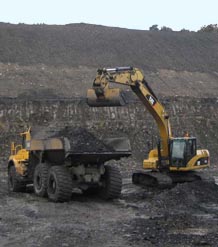Fossil-fuel power plant (coal, natural gas or oil)

A fossil-fuel power plant is one that burns fossil fuels such as coal, natural gas or petroleum (oil) to produce electricity. Fossil-fuel power plants are designed on a large scale for continuous operation.
In many countries, such plants provide most of the electrical energy used, or the ‘baseload’. A fossil fuel power plant uses a turbine that turns an electrical generator. The turbine may be turned by steam, gas or — as in some small isolated plants — an internal combustion engine.
Power plants produce by-products. Waste heat is released to the atmosphere, often via a cooling tower, or river or lake water as a cooling medium. Waste gas (flue gas) from burning of the fossil fuels is discharged to the air; this contains carbon dioxide and water vapour, as well as other substances such as nitrogen, nitrous oxides, sulphur oxides, and (in the case of coal-fired plants) fly ash and mercury.
Solid waste ash from coal-fired boilers must also be removed, and some coal ash can be recycled for building materials.
See future CCS options Post-combustion coal fired power plant.







